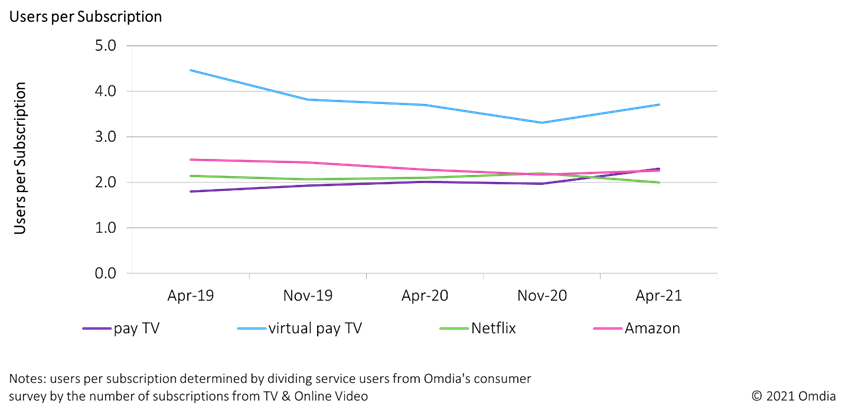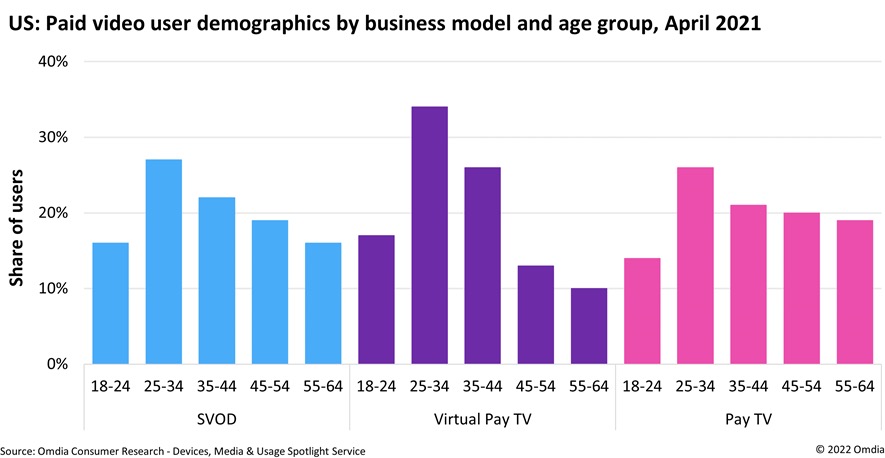vMVPD on the rise in the US
 The average US virtual pay TV user in 2021 used 13.5 video services per month compared to the average video household at 7.4 services.
The average US virtual pay TV user in 2021 used 13.5 video services per month compared to the average video household at 7.4 services.
According to new figures from Omdia, subscribers to virtual multiprogramming video distributors (vMVPD) represent 11% of all TV households as traditional pay TV subscriptions continue to decline.
Traditional pay TV subscriptions in the US saw a 7% decline in 2021, ending the year with 69.7 million households (HH) with a traditional pay-TV subscription. Of the 125.1 million TV HH in the US, 55.4 million will be left without a traditional linear experience. At the end of 2021, there were 13.6 million virtual pay-TV subscriptions in the US representing approximately 11% of TV households.
Omdia analysis also shows that virtual pay TV in the US has continued to have more users per subscription than traditional pay TV, Netflix, and Amazon. In April 2021, virtual pay TV had 3.7 users per subscription on average while traditional pay TV had 2.3. This higher proportion of users to subscriptions may be multiple households sharing one singular virtual pay TV subscription. Unlike pay TV, some virtual pay TV services offer multiple profiles per subscription, which could encourage password sharing. Splitting a virtual pay TV subscription across two households would also bring down the high cost of virtual pay TV that consumers have been reluctant to get locked into.
Although virtual pay TV users are highly engaged, price hikes continue to push consumers to fully cut the cord and just rely on SVOD or AVOD services. Average monthly pricing for a vMVPD service in the US in 2021 was US$58.89 per month compared to US$99.44 for traditional pay TV and US$8.75 for SVOD.
 Sarah Henschel, principal analyst at Omdia, said: “Because virtual pay-TV services are internet-based and have no long-term contracts like traditional pay TV, user interfaces and experiences are received well and can adapt to changing customer needs.
Sarah Henschel, principal analyst at Omdia, said: “Because virtual pay-TV services are internet-based and have no long-term contracts like traditional pay TV, user interfaces and experiences are received well and can adapt to changing customer needs.
“These users are more than twice as likely to use transactional video services (both retail and rental), with this growing to 3x as likely for premium video on demand (PVOD) and more than 5x for sport pay-per-view (PPV). Virtual pay-TV users are also almost 3x as likely to have pirated video content. This over-indexing highlights that these consumers are content-hungry and are able to find the content they need – through paid means or otherwise.”
Max Signorelli, senior analyst at Omdia, added: “US virtual pay TV users skew toward high income 25 to 44-year-old males with interest in TV shows and sports. Live sports is one of the driving growth factors behind virtual pay TV, but it is still niche in size compared to pay TV or SVOD. US virtual pay TV accounted for 7% of subscription revenue but only 3% of total subscriptions.”



